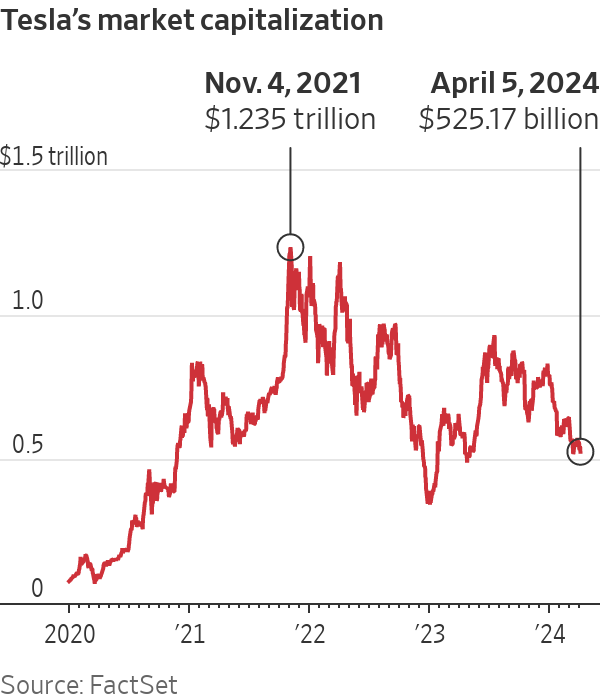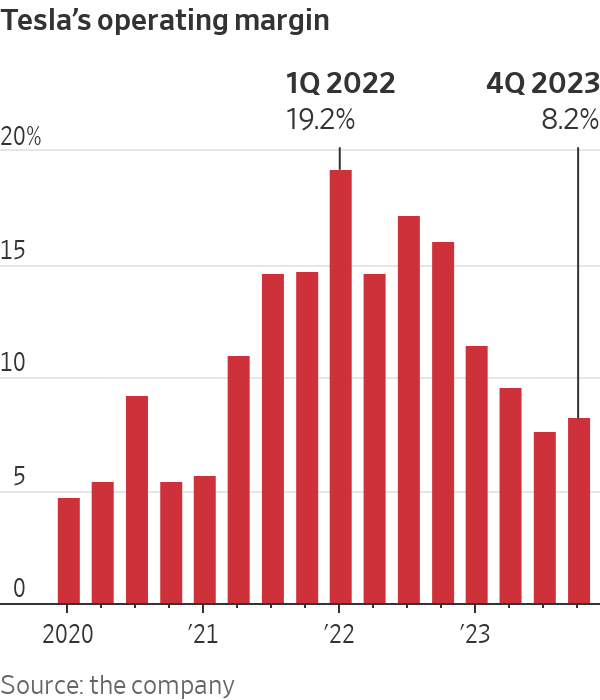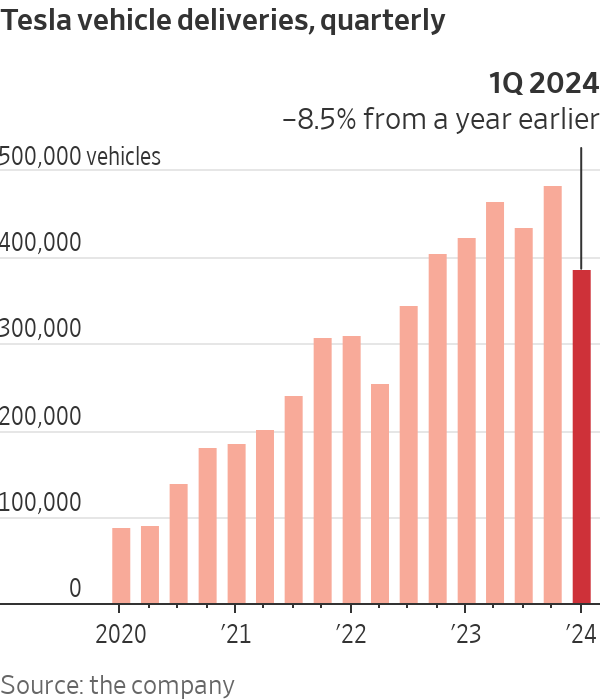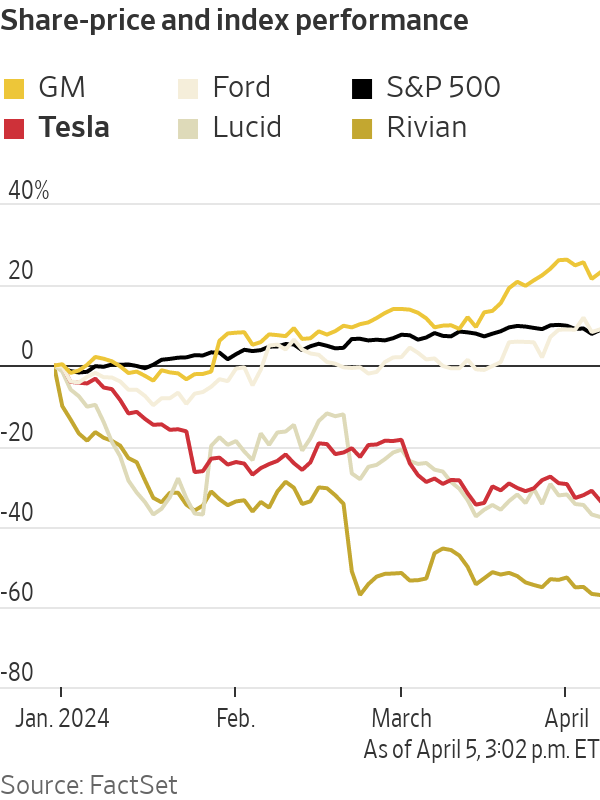The Inside Tale of Tesla’s Fall to Earth
Sales are dropping. It’s cutting prices. And its latest big bets have yet to pan out. Can the world’s most valuable carmaker get its mojo back?
Sales are dropping. It’s cutting prices. And its latest big bets have yet to pan out. Can the world’s most valuable carmaker get its mojo back?
Tesla Chief Executive Elon Musk has spent years trying to build the automaker of the future. It’s the electric-car company of the present that’s now giving him trouble.
After a period of rapid expansion, the company has seen its sales fall and its once-enviable margins shrink. For the first time in years, the biggest question for Tesla is not whether it will be able to make enough cars, but whether people will buy them.
The company’s stock, down 34% this year, has been the worst performer in the S&P 500 index. While Tesla remains the world’s most valuable automaker by a wide margin, its market capitalisation has tumbled by more than half since it peaked in 2021.
Consumer appetite for electric vehicles is cooling. The core of Tesla’s lineup is dated. The company has been cutting prices to spur demand. Big, moonshot bets have not panned out as Musk predicted—at least not yet. And Chinese carmakers are now the ones that look like nimble, tech-savvy upstarts.
Musk’s attention, meanwhile, has sometimes been elsewhere. He bought Twitter, sold some Tesla stock along the way and started an artificial-intelligence company . Of late, he has been picking fights with everyone from OpenAI to Disney Chief Executive Bob Iger . Surveys suggest his public persona has alienated some would-be Tesla buyers.
This week, the company reported its first year-over-year decline in quarterly deliveries since 2020—a result that badly missed Wall Street’s expectations.
Musk’s company remains a formidable player in the electric-vehicle market globally and is the clear leader in the U.S. It is still making money on its vehicles, while many established car companies are struggling to turn a profit on their EVs, after committing tens of billions of dollars to expand their offerings. But the boom times of Tesla’s past have faded, and the bright future imagined by Musk—where people will ride around in fully autonomous Teslas—remains distant.
“Tesla is going from the golden era to a really challenging era,” said Mark Fields , a former CEO of Ford Motor who now serves on several corporate boards. Tesla and Musk didn’t respond to requests for comment.
Three years ago, Tesla appeared all but unstoppable.
After years of financial uncertainty and production challenges, the company had turned a corner and was delivering quarter after quarter of record profit.
Its factories were humming , even as a global shortage of semiconductors led many rivals to curtail auto production. Consumer demand was strong enough that Tesla was hiking prices, and waiting lists for new vehicles grew long enough that some buyers were paying a premium for lightly used ones.
As automakers set about remaking themselves in Tesla’s image, Musk—a master salesman with an uncanny knack for inspiring investors to believe in his vision —sought to catch the next market wave: artificial intelligence.
At a Tesla recruiting event in the summer of 2021, the billionaire took the stage in Palo Alto, Calif., dressed all in black, as is his custom.
Tesla had for years been working to develop technology that would allow a computer to assume more of the driving tasks, rolling out the software as part of its Autopilot system.
In an attempt to emphasise Tesla’s might in the artificial-intelligence space—and ambitions beyond the competitive, traditionally low-margin automotive business—Musk unveiled the company’s latest effort: a friendly humanoid robot. The robot, Optimus, was not ready yet. In its place, a human dressed in a robot costume danced on stage.
“Tesla is much more than an electric-car company,” Musk told the crowd. “In the future, physical work will be a choice.”
In late October 2021, rental-car company Hertz Global Holdings said it was ordering 100,000 Tesla vehicles as it looked to expand its fleet of EVs. For investors, the deal was a sign that EVs were becoming mainstream—and soon more drivers would have an opportunity to try one.
Tesla’s market value eventually peaked above $1.2 trillion in early November, up more than 2,000% in two years.

The euphoria was short-lived.
Musk soon began unloading Tesla stock, embarking on a spree that continued for more than a year and resulted in his selling more than $39 billion in shares. The sales—executed in part to fund Musk’s eventual purchase of Twitter—spooked the market and weighed on Tesla’s stock.
The surprises kept coming in 2022.
On a late-January earnings call, Musk revealed Tesla would not be introducing any new models that year, attributing the decision to supply-chain constraints. Instead, the company would churn out as many of its existing models as possible.
Tesla sold four models at the time, but just two drove the lion’s share of the company’s sales: the Model Y sport-utility vehicle and the Model 3 sedan.
Plans for a $25,000 car—a model Musk had teased in late 2020 and said likely would be ready in three years—had been put on ice.
“We have enough on our plate right now,” Musk said.
The move was risky. In the car business, new and redesigned models are critical to holding buyers’ interest and maintaining pricing power.
Analysts were perplexed. One questioned whether Tesla could hit its growth targets with fewer than a half-dozen passenger-vehicle models in its lineup.
Musk brushed off the concern. Instead, he alluded to his vision for a future where Teslas would be able to operate autonomously around the clock—making them even more valuable.
“It’s apparent from the questions that the gravity of Full Self-Driving is not fully appreciated,” Musk said, referring to a souped-up version of Tesla’s driver-assistance technology. (The system doesn’t currently make Tesla vehicles autonomous.)
As the year wore on, investors grew increasingly jittery. Musk’s pursuit of Twitter only amplified concerns on Wall Street that the Tesla CEO was not focused enough on his carmaker.
“Twitter is a distraction,” Gary Black, managing partner of the Future Fund, a Tesla investor, said at the time. “All of the space has been sucked up by him talking about Twitter, and so you don’t hear him tweeting about EVs.”
Warning signs flashed in China, where wait times for new Teslas fell to about a month as of September 2022, from four-plus months in the spring, according to Bernstein Research.
Tesla executives, including chief designer Franz von Holzhausen, pressed Musk to revive plans for the company’s more affordable, mass-market car, arguing it was necessary for Tesla to reach its growth targets, according to Walter Isaacson ’s biography of the CEO. Musk had been more interested in developing autonomous cars that could operate in a robotaxi fleet.

“Our responsibility is to try to get as many people into an EV as possible,” von Holzhausen told The Wall Street Journal earlier this year.
And while he is optimistic about the promise of self-driving cars and encouraged by Tesla’s recent progress, von Holzhausen said the transition will not be simple.
“Maybe I’m more pragmatic about it, but I think autonomy is…it’s going to be a challenge,” he said. “It’s still sci-fi to a lot of people.”
In late October, Tesla cut prices in China by an average of around 7%, according to Bernstein.
Soon after, it began offering temporary discounts on its most popular models in the U.S.—by $3,750 at first, then $7,500 plus 10,000 miles of free fast-chargin g if customers took delivery before year-end.
Tesla’s 2022 ended on a downbeat note. Its annual vehicle deliveries—up 40% over the prior year— fell short of the company’s initial goal and underperformed Wall Street’s expectations. The stock suffered its worst annual performance on record, declining 65%.
By early January 2023, it became clear within Tesla’s finance department that the company needed to take more aggressive action to move cars, people familiar with the matter said.
Tesla had opened two new factories in 2022—one in Germany and another in Texas—expanding its production capacity roughly 80% in less than a year. Unsold inventory climbed to 13 days’ worth of supply in the final three months of 2022, from just four days in the second quarter, according to Tesla’s financial disclosures.
As January unfolded, orders weren’t keeping pace with internal forecasts, one of the people said.
Employees developed a plan that called for Tesla to cut prices more permanently, an unusual strategy in an industry where companies typically try to be more discreet with their incentives.
Elsewhere in the auto industry, Tesla’s rivals were unleashing a barrage of new EV models, including ones designed to directly compete with the Model Y and Model 3.
On a Thursday night in January 2023, Tesla quietly updated its website, slashing prices across its lineup, in some cases by nearly 20%.
Tesla made cuts that were even deeper than the finance department had initially proposed, the people familiar with the matter said.
For Musk, it was a calculated gamble. Tesla’s double-digit operating margins meant it could better absorb the price cuts than rivals, and the move would also put the squeeze on competitors—many of which were losing money on their EVs.

Across the Atlantic, Vincent Cobée, then-CEO of Stellantis ’s Citroën brand, was at the Brussels Motor Show when a journalist told him about Tesla’s price cuts.
Cobée’s first thought: “He’s completely nuts.”
Then: “We’re in deep trouble,” he recalled later.
The maneouvre did boost sales at Tesla—for a time. The company’s vehicle prices fell by an average of 12% globally in the first half of 2023, and deliveries rose 19% compared with the prior six months, according to Wells Fargo.
But in the second half of 2023, as Tesla continued to lower prices and layer on incentives, the company’s vehicle-delivery growth slowed to 3%, compared with the first half—a figure that Wells Fargo analysts described as “concerningly low.”
Some in the auto industry were also starting to sour on electric vehicles.
Dealers who once were bullish about the technology began worrying about the cars stacking up on their lots. Companies that had been racing to scale up EV production suddenly began delaying their investments and shifting their attention to hybrids, which were selling well.
For Tesla, the only new model on the horizon was the Cybertruck—a long-delayed and difficult-to-manufacture pickup truck that eventually hit the market in November . Even so, the model is only available in North America, and Musk has warned it is unlikely to generate significant cash flow before the end of this year.

In China, the world’s largest car market and a production hub for Tesla, a price war had already broken out. The country’s leading EV maker, BYD, and other Chinese car manufacturers were mounting their own offensive, rapidly releasing more affordable EVs that were winning over the domestic market and beginning to make inroads overseas.
In January of this year, Hertz delivered another blow, saying it was selling about a third of its global EV fleet —much of it made up of Tesla vehicles. The rental-car company had previously flagged problems with fast-falling EV resale values and pricey repairs.
Then came the news from earlier this week: Tesla delivered 386,810 vehicles globally in the first three months of 2024, down 8.5% from a year earlier . It was the company’s lowest quarterly performance since the third quarter of 2022.
Wall Street analysts had slashed their expectations for Tesla’s first-quarter performance in the weeks before the disclosure on Tuesday, but the company still came up short.

Musk has sought to quell concerns by describing the company as being in between two growth waves—the first driven by the Model 3 and Model Y, the second to be propelled by the company’s next generation of vehicles, including the much-anticipated low-cost car , which he said in January is due to enter production in late 2025.
In recent weeks, employees were told to prioritise development of a robotaxi, according to a person familiar with the matter.
Reuters on Friday reported that Tesla had canceled plans for the inexpensive car. Musk denied the report on X, as Twitter is now known. Hours later, he added that Tesla plans to unveil its robotaxi model in August.
As Musk has used his social-media platform to address polarising topics such as immigration and race, there is evidence that Musk is doing Tesla no favours with his extracurricular activities.
The company’s reputation among potential U.S. buyers has taken a hit since Musk acquired Twitter, according to market-intelligence firm Caliber. The automaker’s “consideration” rate—where survey respondents said whether they are very likely to buy, or continue buying, products from Tesla—fell from 46% to 35% between September 2022 and this March, Caliber said.
As Tesla’s profitability has weakened, Musk has talked up the potential of the company’s autonomous-driving strategy.
“Most people still have no idea how crushingly good Tesla FSD will get,” he posted on X in late March. “Cars will take you where you want automatically, just like getting in an elevator and pressing a button, something that also used to be manual.”

Despite the recent stock decline, Tesla’s valuation—$525 billion at Friday’s close—still towers over those of other automakers.
Many investors remain confident that Musk, who has defied the odds many times before, can deliver on this vision. Some, such as Owuraka Koney, a managing director at investment manager Jennison Associates, are betting Tesla will be able to generate ample revenue by selling downloadable software, such as its driver-assistance technology, long after it makes that initial car sale.
Said Koney: “We remain very bullish over the long-term.”
— Ryan Felton, Tim Higgins, Mike Colias and Sean McLain contributed to this article.
 Copyright 2020, Dow Jones & Company, Inc. All Rights Reserved Worldwide. LEARN MORE
Copyright 2020, Dow Jones & Company, Inc. All Rights Reserved Worldwide. LEARN MORE
What a quarter-million dollars gets you in the western capital.
Alexandre de Betak and his wife are focusing on their most personal project yet.
CIOs can take steps now to reduce risks associated with today’s IT landscape
As tech leaders race to bring Windows systems back online after Friday’s software update by cybersecurity company CrowdStrike crashed around 8.5 million machines worldwide, experts share with CIO Journal their takeaways for preparing for the next major information technology outage.
IT leaders should hold vendors deeply integrated within IT systems, such as CrowdStrike , to a “very high standard” of development, release quality and assurance, said Neil MacDonald , a Gartner vice president.
“Any security vendor has a responsibility to do extensive regression testing on all versions of Windows before an update is rolled out,” he said.
That involves asking existing vendors to explain how they write software, what testing they do and whether customers may choose how quickly to roll out an update.
“Incidents like this remind all of us in the CIO community of the importance of ensuring availability, reliability and security by prioritizing guardrails such as deployment and testing procedures and practices,” said Amy Farrow, chief information officer of IT automation and security company Infoblox.
While automatically accepting software updates has become the norm—and a recommended security practice—the CrowdStrike outage is a reminder to take a pause, some CIOs said.
“We still should be doing the full testing of packages and upgrades and new features,” said Paul Davis, a field chief information security officer at software development platform maker JFrog . undefined undefined Though it’s not feasible to test every update, especially for as many as hundreds of software vendors, Davis said he makes it a priority to test software patches according to their potential severity and size.
Automation, and maybe even artificial intelligence-based IT tools, can help.
“Humans are not very good at catching errors in thousands of lines of code,” said Jack Hidary, chief executive of AI and quantum company SandboxAQ. “We need AI trained to look for the interdependence of new software updates with the existing stack of software.”
An incident rendering Windows computers unusable is similar to a natural disaster with systems knocked offline, said Gartner’s MacDonald. That’s why businesses should consider natural disaster recovery plans for maintaining the resiliency of their operations.
One way to do that is to set up a “clean room,” or an environment isolated from other systems, to use to bring critical systems back online, according to Chirag Mehta, a cybersecurity analyst at Constellation Research.
Businesses should also hold tabletop exercises to simulate risk scenarios, including IT outages and potential cyber threats, Mehta said.
Companies that back up data regularly were likely less impacted by the CrowdStrike outage, according to Victor Zyamzin, chief business officer of security company Qrator Labs. “Another suggestion for companies, and we’ve been saying that again and again for decades, is that you should have some backup procedure applied, running and regularly tested,” he said.
For any vendor with a significant impact on company operations , MacDonald said companies can review their contracts and look for clauses indicating the vendors must provide reliable and stable software.
“That’s where you may have an advantage to say, if an update causes an outage, is there a clause in the contract that would cover that?” he said.
If it doesn’t, tech leaders can aim to negotiate a discount serving as a form of compensation at renewal time, MacDonald added.
The outage also highlights the importance of insurance in providing companies with bottom-line protection against cyber risks, said Peter Halprin, a partner with law firm Haynes Boone focused on cyber insurance.
This coverage can include protection against business income losses, such as those associated with an outage, whether caused by the insured company or a service provider, Halprin said.
The CrowdStrike update affected only devices running Microsoft Windows-based systems , prompting fresh questions over whether enterprises should rely on Windows computers.
CrowdStrike runs on Windows devices through access to the kernel, the part of an operating system containing a computer’s core functions. That’s not the same for Apple ’s Mac operating system and Linux, which don’t allow the same level of access, said Mehta.
Some businesses have converted to Chromebooks , simple laptops developed by Alphabet -owned Google that run on the Chrome operating system . “Not all of them require deeper access to things,” Mehta said. “What are you doing on your laptop that actually requires Windows?”